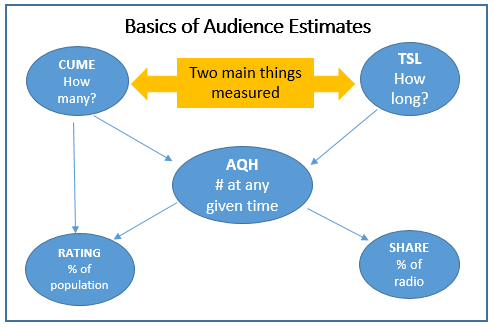
Hot Topics
Back to Basics: Ratings vs. Shares – What’s the difference?
February 17, 2022
Many of you are probably thinking … Why do I need to know this? Simply put, they are both percentages yet percentages of two different bases or universes.
In last month’s Back to Basics post, we discussed Cume, Time Spent Listening (TSL), and Average Quarter-Hour (AQH). Now let’s explore the meaning and importance of Ratings and Shares.

RATINGS represent a percentage of the population. Sometimes radio folks will use the term “Ratings” when they really mean shares. “Ratings” is also a general term for all audience estimates. Ratings can be calculated on both Cume and AQH. A Cume Rating demonstrates market penetration and is used when we talk about Radio’s reach. “Radio reaches 92% of the market.” This means that 92% of the population listens to radio (and please source the demo and daypart). This estimate works great for local sales to demonstrate the mass appeal of your station or when comparing to other media – especially print.
AQH Ratings represent the percentage of the population listening at any given time … or percentage reached with each commercial. AQH Ratings are mostly used for agency sales. GRPs (Gross Rating Points) and CPP (Cost Per Point) are calculated from AQH Ratings. We will discuss these estimates in a later blog.
The last of our basic terms is SHARE. Shares represent a percentage of the Radio pie. Instead of considering the entire population, we are now only looking at those people who listen to radio. Shares are only calculated on AQH so that your Radio pie will be 100%. Remember, AQH represents listening at any given time. You can only be listening to one radio station at a particular time, so shares will add to 100. Programmers love talking about shares, and they want the largest shares possible. You can’t blame them … it’s their report card, so be kind to them if your station sees a decline in share. Now you know that several factors go into that number – # of people listening, how long, and the size of Radio’s pie.
Are you comfortable with what you can and can’t do with estimates? If not, no worries. Most of us need a little guidance, which we will provide next month. This is the critical nuts and bolts of audience estimates, so you won’t want to miss it!
For more info, reach out to us here.
-Karen Morriss, Director of Client Services
Comments